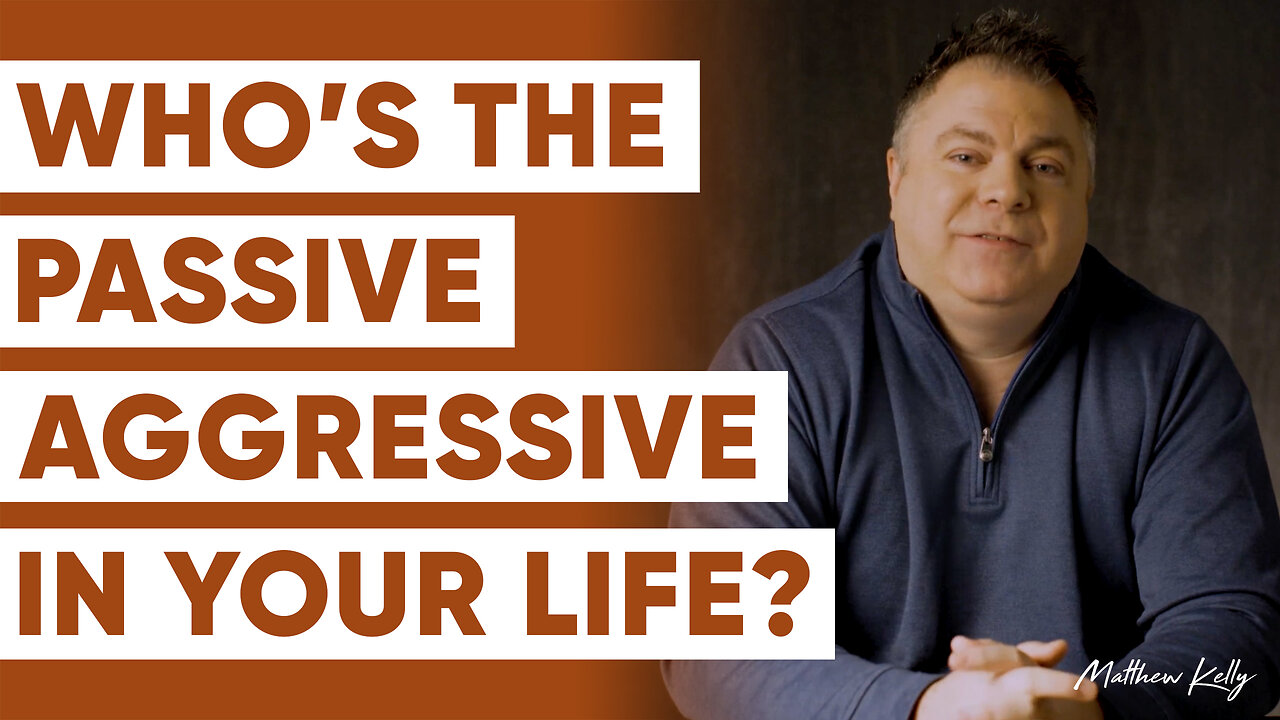Premium Only Content

How to Recognize Passive-Aggressive Behavior (And What to do About It!) - Matthew Kelly
Who’s the Passive-Aggressive in Your Life?
How to Recognize Passive-Aggressive Behavior (And What to do About It!) - Matthew Kelly
Get Matthew’s 60 Second Wisdom delivered to your inbox: https://www.matthewkelly.com/subscribe
Video Transcript:
“Most of us encounter passive-aggressive behavior on a daily basis. It could be as simple and innocent as a child who is unable to express her feelings or an adult who is intentionally trying to manipulate and control us.
What is passive-aggressive behavior? It’s a pattern of indirectly expressing negative feelings instead of openly addressing them.
The first important word to connect with out of this definition is ”pattern”. It isn’t something that happens once. When something happens once, it’s an event. If something happens twice, depending on how serious something is, we may be willing to give people the benefit of the doubt. But once something happens three times, it’s a pattern.
An example of passive-aggressive behavior is someone who agrees to something you ask them to do, perhaps even agrees enthusiastically, but then expresses anger and resentment by failing to complete the task or missing deadlines.
Passive-aggressive behavior often involves using inaction to punish or control people. It also usually involves refusing to express thoughts, feelings, opinions, and desires in a mature way.
Passive-aggressive people attempt to get what they need or want indirectly and manipulatively. They act out aggressive impulses in an indirect way. For example, they might say, “Don’t bother. I guess I’ll just have to do it myself” as a way to guilt and manipulate you into doing what they want you to do right now. Instead of simply asking you to do something and explaining why it matters to them.
Other examples of passive-aggressive behavior include: Resentment and opposition to reasonable requests; sulking; backhanded compliments; withdrawal; procrastination; intentional mistakes; refusing to communicate; cynical, sullen, or hostile attitudes; and frequent complaining.
When someone is behaving in one or more of these ways, it’s important to control your anger and explain what you are witnessing and experiencing in a non-judgmental, factual way.
For example, you might say to your child, "You seem to be angry at me for asking you to clean your room." Or you might say to your partner, “You agreed to come with me today, but now you seem resentful and angry at having to come.”
Remember, passive-aggressive behavior is a pattern of indirectly expressing negative feelings, instead of addressing them openly. When a person is engaging in passive-aggressive behavior, there is always a disconnect between what that person says and what he or she does.
Passive-aggressive behavior interferes with millions of personal and professional relationships every day. It sucks the joy out of doing things together, makes difficult things even more difficult, it is exhausting, and can lead us to doubt ourselves and question whether something is wrong with us. Once someone gets us into this fragile psychological state, we are easier than ever to manipulate.
What’s the solution? Learn to recognize passive-aggressive behavior in your life, and don’t delay in pointing it out when you see it being used.”
If you have not read LIFE IS MESSY, order your copy today: https://amzn.to/2TTgZKn
Subscribe to Matthew’s YouTube Channel today! https://www.youtube.com/c/MatthewKellyAuthor/featured?sub_confirmation=1
Get Matthew’s 60 Second Wisdom delivered to your inbox: https://www.matthewkelly.com/subscribe
The Best Version of Yourself and 60 Second Wisdom are registered trademarks.
#MatthewKelly #BestVersionOfYourself #BestVersion #ThoughLeader
-
 1:06
1:06
Matthew Kelly
2 years agoThe Pomodoro Technique: Make Work More ENJOYABLE - Matthew Kelly
42 -
 10:45
10:45
Dr. Nick Zyrowski
1 day agoDoctors Got It Wrong! This Causes of Obesity - NOT Sugar
5.7K8 -
 1:57:57
1:57:57
The Charlie Kirk Show
2 hours agoSummit Aftermath + America's Energy Revolution + Where Russiagate Will Lead | Wright, Solomon
33.7K11 -
 2:00:15
2:00:15
Steven Crowder
5 hours agoTrump's Huge Meeting Shocks the World & the Media is Dumbfounded
246K198 -
 LIVE
LIVE
Viss
2 hours ago🔴LIVE - How to Consistently Win in PUBG!
95 watching -
 LIVE
LIVE
GloryJean
4 hours agoSniping & Dominating Solos 🖱️ 6.7 K/D
22 watching -
 1:40:15
1:40:15
Nikko Ortiz
3 hours agoLive - Gun Shot And Gun Fails
31.1K6 -
 1:02:10
1:02:10
VINCE
5 hours agoWhat Just Happened At The White House? | Episode 106 - 08/19/25
193K264 -
 LIVE
LIVE
LFA TV
7 hours agoLFA TV ALL DAY STREAM - TUESDAY 8/19/25
2,711 watching -
 1:18:04
1:18:04
The Big Mig™
6 hours agoTrump, NO More Voter Fraud It’s Time, LFG
27.4K10